ANOMALOUS IMAGES FROM APOLLO
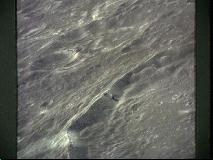 This
is a view of the side of Lobachevsky crater as photographed by the Apollo
16 astronauts. Note the dark anomaly in the side of the crater. The white
streak is an artifact produced by the digital scanning process, but there
is a very bright white cap or bright round feature which can be seen in
the Clementine images, as well as the unusual dark area. NASA identifies
the dark feature as a lava flow. However, this feature exhibits apparent
shading suggesting that it may be a crevass. There is also an unusual bluish
'pillbox' object to the right of the rim, in the base of the crater. The
coordinates of the dark anomaly are 10.0 N latitude, 111.6 E longitude.
This
is a view of the side of Lobachevsky crater as photographed by the Apollo
16 astronauts. Note the dark anomaly in the side of the crater. The white
streak is an artifact produced by the digital scanning process, but there
is a very bright white cap or bright round feature which can be seen in
the Clementine images, as well as the unusual dark area. NASA identifies
the dark feature as a lava flow. However, this feature exhibits apparent
shading suggesting that it may be a crevass. There is also an unusual bluish
'pillbox' object to the right of the rim, in the base of the crater. The
coordinates of the dark anomaly are 10.0 N latitude, 111.6 E longitude.
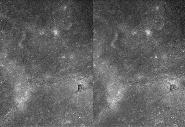 These
are two stereo images of the anomalous feature in the side of Lobachevsky,
from Clementine. Note the cave-like appearance of the feature, which is
not completely dark as would be expected with a lava flow. Notice the several
linear features which appear to form a bridge from the rim of the crater
to the 'island' in the center of the feature. There is also a spherical
object at the top of the island, as well as two small dark spots at the
base of the 'island', which appears to have a horizontal linear feature
just below the two dark spots. Also, note the two bright spots below the
dark feature which correspond to the blue objects in the image from Apollo.
These
are two stereo images of the anomalous feature in the side of Lobachevsky,
from Clementine. Note the cave-like appearance of the feature, which is
not completely dark as would be expected with a lava flow. Notice the several
linear features which appear to form a bridge from the rim of the crater
to the 'island' in the center of the feature. There is also a spherical
object at the top of the island, as well as two small dark spots at the
base of the 'island', which appears to have a horizontal linear feature
just below the two dark spots. Also, note the two bright spots below the
dark feature which correspond to the blue objects in the image from Apollo.
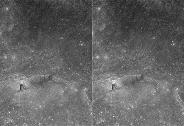 The
shape of this part of the crater appears to have changed significantly
since the Apollo image was taken over 20 years earlier. Could this area
have been changed as the result of excavation or mining operations being
conducted in the area?
The
shape of this part of the crater appears to have changed significantly
since the Apollo image was taken over 20 years earlier. Could this area
have been changed as the result of excavation or mining operations being
conducted in the area?
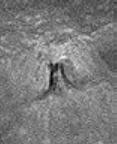 Here
is a closeup of the anomalous feature.
Here
is a closeup of the anomalous feature.
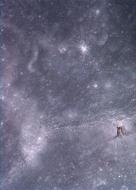
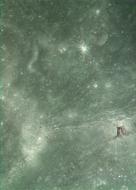
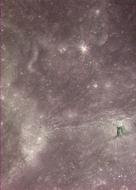 These
are various permutations of the 900, 950 and 1100 nm images from Clementine
combined into false color images. The ..._cde, correspond to the red-green-blue
color mapping: C = 900 nm, D = 950 nm, E = 1100 nm. Notice the predominance
of 900 nm reflectance of the minerals around the anomaly on the side of
Lobachevsky and the other points which exibit a similar 900 nm refectivity
as evidenced by the anomalous coloration over the predominately 1100 nm
background.
These
are various permutations of the 900, 950 and 1100 nm images from Clementine
combined into false color images. The ..._cde, correspond to the red-green-blue
color mapping: C = 900 nm, D = 950 nm, E = 1100 nm. Notice the predominance
of 900 nm reflectance of the minerals around the anomaly on the side of
Lobachevsky and the other points which exibit a similar 900 nm refectivity
as evidenced by the anomalous coloration over the predominately 1100 nm
background.
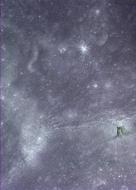
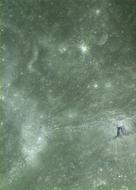
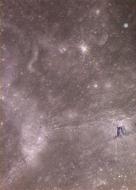
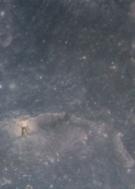
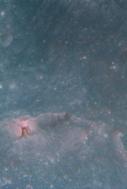
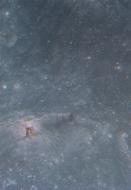
These are more false color images made from 450, 750, 900, 950 and 1100 nm images
from Clementine. The there is increased reflectivity at 450 and 900 nm
by materials surrounding the anomaly which may lead to clues about how
it was formed.
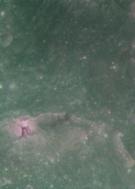
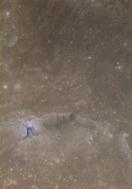
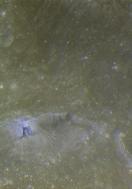
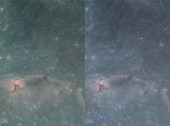 This
is a false-color multi-spectral 'stereo' image of the Lobachevsky anomaly
made from 450, 900, and 950 nm images mapped to red-green-blue on the left,
and 750, 900, and 1100 nm images mapped to r-g-b on the right. The bright
'cap' is clearly visible at above the dark anomaly. Additional details
can be seen in the crater floor including ejecta trails and unusual linear
structures to the right of the anomaly at the base and across the face
of the crater. The blue 'pillbox' object can be seen at the lower right,
which appears to bisected by a linear object which causes the pillbox to
appear to be two separate objects in some of the Clementine images.
This
is a false-color multi-spectral 'stereo' image of the Lobachevsky anomaly
made from 450, 900, and 950 nm images mapped to red-green-blue on the left,
and 750, 900, and 1100 nm images mapped to r-g-b on the right. The bright
'cap' is clearly visible at above the dark anomaly. Additional details
can be seen in the crater floor including ejecta trails and unusual linear
structures to the right of the anomaly at the base and across the face
of the crater. The blue 'pillbox' object can be seen at the lower right,
which appears to bisected by a linear object which causes the pillbox to
appear to be two separate objects in some of the Clementine images.
This is the original .tif version (540K)
of the above image. Note the imprvoment in low level detail compared
to the .jpg above which was saved with
a compression factor of only 5%.
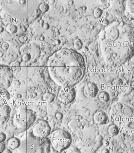 This
is a portion of the Far NE farside map
of this area.
This
is a portion of the Far NE farside map
of this area.
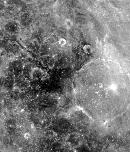 This
is a large browse image of the area. Lobachevsky is the large crater on
the right. The dark anomaly appears at approximately 8:30.
This
is a large browse image of the area. Lobachevsky is the large crater on
the right. The dark anomaly appears at approximately 8:30.
Tom Carey:
Radiating antisunward from the vertical anomaly, there appears to be
a faint line across the crater floor, aligned toward the string of three
small craters near the brightly lit mound at the right hand edge of the
image, and reaching just under half the distance to that mound. A second
fainter line with the same origin and approximate length can be seen approximately
10 degrees clockwise from the first.
These lines may or may not be shadows, but ought to be considered as
associated with the anomaly.
Jon, VGL:
Guys I have been looking at that black streak and my copy of "Geologic
Answers for All Anomalies" sez it could only be 3 things:
1. Highly carbonized petroleum oil (just kidding)
2. A highly unusual Obsidian flow (volcanic glass)
3. A deep crack or fissure in the surface
I am leaning toward answer number 3, because the far wall of the opening
appears to be sloping toward the black area. That may a trick of light
and shadow but while we await higher resolution that is my call.
The blue pill? I have no idea. Anyone have any idea how big that thing
is?
Lan Flemming:
In the Clementine image that Steve found - which is very good, byt the
way - the black streaks do look like they're following crevices in the
surface, so they might just be deep, shadowed cracks. However, the sun
angle in the Clem photos is very high, and the bottom surfaces of all but
the deepest cracks should be exposed to sunlight and therefore not appear
black. I noticed what appear to be rays extending out from the small crater
in the same direction as the black streaks, so those streaks may have something
to do with the impact that formed the small crater. But the streaks might
also be some sort of liquid that slopped out of the crater long after the
impact and just flowed down the path of least resistance (the deepest crevices
in the surface of Lobachevsky).
Farouk El-Baz: "This is an oblique view looking northwest at part
of the wall of the crater Lobachevsky (not Guyat) on the lunar far side.
It shows a small crater on Lobachevsky's wall with unusual streaks of dark
material that appeared to have originated from the lower rim of the structure
and to have moved down the floor of Lobachevsky. This feature was first
noticed by T. K. Mattingtly, the Apollo 16 CMP, who described the darker
streaks as possible lava flows (Mattingtly, El-Baz, and Laidley, 1972).
However, the streaks can also be explained by the downslope movement of
dark fragmental debris excavated from Lobachevsky's wall by the small crater.
Closer to the lower border of the photograph is a bright area extending
across Lobachevsky's rim. This area and other sinuous light-colored markings
in the upper half of the photograph are on the periphery of an enormous
field of light-colored swirls in this part of the far side (El-Baz, 1972a).
The origin of the swirls is not well understood."
-- "Apollo Over the Moon: A View From Orbit"
Here is NASA's description, which misidentifies the crater as Guyot
rather than Lobachevsky:
Title: Oblique view of rim of Guyot crater on lunar farside as seen
by Apollo 16 Description: An oblique view of a rim of Guyot crater on the
lunar farside, as photographed from the Apollo 16 spacecraft in lunar orbit.
The coordinates of the center of Guyot crater are 116.5 degrees east longitude
and 10.5 degrees north latitude. Note the black coloration which appears
to be lava flow down the side of the crater rim.
NASA Photo ID: AS16-121-19407 File Name: 10075825.jpg Film Type: 70mm
Date Taken: 04/18/72

Return To Home Page
Last Updated: 10:00PM on 5/6/98
 This
is a view of the side of Lobachevsky crater as photographed by the Apollo
16 astronauts. Note the dark anomaly in the side of the crater. The white
streak is an artifact produced by the digital scanning process, but there
is a very bright white cap or bright round feature which can be seen in
the Clementine images, as well as the unusual dark area. NASA identifies
the dark feature as a lava flow. However, this feature exhibits apparent
shading suggesting that it may be a crevass. There is also an unusual bluish
'pillbox' object to the right of the rim, in the base of the crater. The
coordinates of the dark anomaly are 10.0 N latitude, 111.6 E longitude.
This
is a view of the side of Lobachevsky crater as photographed by the Apollo
16 astronauts. Note the dark anomaly in the side of the crater. The white
streak is an artifact produced by the digital scanning process, but there
is a very bright white cap or bright round feature which can be seen in
the Clementine images, as well as the unusual dark area. NASA identifies
the dark feature as a lava flow. However, this feature exhibits apparent
shading suggesting that it may be a crevass. There is also an unusual bluish
'pillbox' object to the right of the rim, in the base of the crater. The
coordinates of the dark anomaly are 10.0 N latitude, 111.6 E longitude.
 These
are two stereo images of the anomalous feature in the side of Lobachevsky,
from Clementine. Note the cave-like appearance of the feature, which is
not completely dark as would be expected with a lava flow. Notice the several
linear features which appear to form a bridge from the rim of the crater
to the 'island' in the center of the feature. There is also a spherical
object at the top of the island, as well as two small dark spots at the
base of the 'island', which appears to have a horizontal linear feature
just below the two dark spots. Also, note the two bright spots below the
dark feature which correspond to the blue objects in the image from Apollo.
These
are two stereo images of the anomalous feature in the side of Lobachevsky,
from Clementine. Note the cave-like appearance of the feature, which is
not completely dark as would be expected with a lava flow. Notice the several
linear features which appear to form a bridge from the rim of the crater
to the 'island' in the center of the feature. There is also a spherical
object at the top of the island, as well as two small dark spots at the
base of the 'island', which appears to have a horizontal linear feature
just below the two dark spots. Also, note the two bright spots below the
dark feature which correspond to the blue objects in the image from Apollo.
 The
shape of this part of the crater appears to have changed significantly
since the Apollo image was taken over 20 years earlier. Could this area
have been changed as the result of excavation or mining operations being
conducted in the area?
The
shape of this part of the crater appears to have changed significantly
since the Apollo image was taken over 20 years earlier. Could this area
have been changed as the result of excavation or mining operations being
conducted in the area?  Here
is a closeup of the anomalous feature.
Here
is a closeup of the anomalous feature. 

 These
are various permutations of the 900, 950 and 1100 nm images from Clementine
combined into false color images. The ..._cde, correspond to the red-green-blue
color mapping: C = 900 nm, D = 950 nm, E = 1100 nm. Notice the predominance
of 900 nm reflectance of the minerals around the anomaly on the side of
Lobachevsky and the other points which exibit a similar 900 nm refectivity
as evidenced by the anomalous coloration over the predominately 1100 nm
background.
These
are various permutations of the 900, 950 and 1100 nm images from Clementine
combined into false color images. The ..._cde, correspond to the red-green-blue
color mapping: C = 900 nm, D = 950 nm, E = 1100 nm. Notice the predominance
of 900 nm reflectance of the minerals around the anomaly on the side of
Lobachevsky and the other points which exibit a similar 900 nm refectivity
as evidenced by the anomalous coloration over the predominately 1100 nm
background. 








 This
is a false-color multi-spectral 'stereo' image of the Lobachevsky anomaly
made from 450, 900, and 950 nm images mapped to red-green-blue on the left,
and 750, 900, and 1100 nm images mapped to r-g-b on the right. The bright
'cap' is clearly visible at above the dark anomaly. Additional details
can be seen in the crater floor including ejecta trails and unusual linear
structures to the right of the anomaly at the base and across the face
of the crater. The blue 'pillbox' object can be seen at the lower right,
which appears to bisected by a linear object which causes the pillbox to
appear to be two separate objects in some of the Clementine images.
This
is a false-color multi-spectral 'stereo' image of the Lobachevsky anomaly
made from 450, 900, and 950 nm images mapped to red-green-blue on the left,
and 750, 900, and 1100 nm images mapped to r-g-b on the right. The bright
'cap' is clearly visible at above the dark anomaly. Additional details
can be seen in the crater floor including ejecta trails and unusual linear
structures to the right of the anomaly at the base and across the face
of the crater. The blue 'pillbox' object can be seen at the lower right,
which appears to bisected by a linear object which causes the pillbox to
appear to be two separate objects in some of the Clementine images.  This
is a portion of the Far NE farside map
of this area.
This
is a portion of the Far NE farside map
of this area.  This
is a large browse image of the area. Lobachevsky is the large crater on
the right. The dark anomaly appears at approximately 8:30.
This
is a large browse image of the area. Lobachevsky is the large crater on
the right. The dark anomaly appears at approximately 8:30.